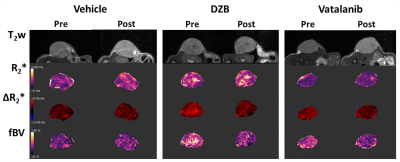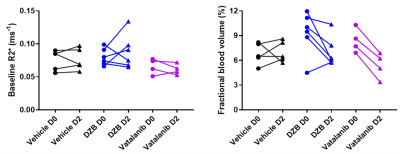Jessica K.R. Boult1, Mahmoud El Shemerly2, Felix Bachmann2, Laurenz Kellenberger2, Heidi Lane2, Paul McSheehy2, and Simon P. Robinson1
1The Institute of Cancer Research, Sutton, United Kingdom, 2Basilea Pharmaceutica International Ltd, Basel 4005, Switzerland
1The Institute of Cancer Research, Sutton, United Kingdom, 2Basilea Pharmaceutica International Ltd, Basel 4005, Switzerland
FGFR inhibitor
derazantinib causes dose-dependent inhibition of endothelial cell proliferation,
VEGFR signalling and vascular permeability in mouse skin, and induces a
reduction in fractional blood volume, as assessed by susceptibility-contrast
MRI, in colorectal tumour xenografts.


